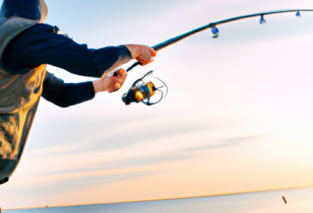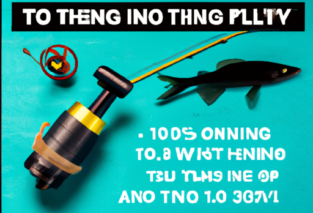August is the month of sunny skies, warm waters, and endless opportunities to cast your line and reel in some fantastic catches. If you’ve ever wondered if it’s possible to go fishing during this summer month, wonder no more. “Can You Go Fishing In August: Summer Fishing Tips And Techniques” is the ultimate guide that will equip you with the necessary knowledge and techniques to make the most out of your fishing adventures in August. Whether you’re a seasoned angler or a beginner, this comprehensive guide provides valuable tips, tricks, and techniques that will enhance your fishing experience and increase your chances of landing that prized catch. So, grab your fishing gear, head to your favorite fishing spot, and get ready to make August a month to remember on the water.

Choosing the Right Fishing Spot
Considering the Temperature of the Waters
When it comes to choosing the right fishing spot, one of the most important factors to consider is the temperature of the waters. Different fish species have different temperature preferences, so it’s crucial to understand which species you are targeting and their preferred temperature range. Warmer water temperatures in the summer can make certain fish more active and more likely to be found in shallower areas, while others may seek cooler depths. By understanding the temperature preferences of the fish you are targeting, you can increase your chances of success.
Identifying Ideal Fishing Locations
In addition to considering water temperature, it’s essential to identify ideal fishing locations. This involves some research and observation. Look for areas that provide cover and protection for fish, such as submerged structures like logs, rocks, or vegetation. Fish tend to congregate around these structures, as they offer shelter and a source of food. Pay attention to areas with a mix of shallow and deep water, as this can offer a variety of habitats for different fish species. Consider factors like water flow, depth, and the presence of baitfish when selecting your fishing spot.
Researching Fish Species Behavior
The final aspect of choosing the right fishing spot involves researching the behavior of the fish species you are targeting. Different species have different feeding patterns, activity levels, and spawning behaviors. By understanding these behaviors, you can narrow down your choices and increase your chances of success. For example, some fish may be more active early in the morning or during certain tidal flows. Others may be more likely to bite when the water temperature reaches a specific range. Researching the behavior of the fish you are targeting will give you valuable insights into their habits and allow you to make more informed decisions about where and when to fish.
Creating a Fishing Plan
Setting Specific Goals
Before heading out to the water, it’s essential to set specific goals for your fishing trip. What do you hope to achieve? Are you aiming to catch a certain species of fish or simply looking to enjoy a relaxing day by the water? Setting specific goals will help you focus your efforts and measure your success. Consider factors like the size or quantity of fish you want to catch, as well as any personal milestones or challenges you want to tackle. By setting specific goals, you can make your fishing trip more purposeful and rewarding.
Determining the Best Fishing Times
To maximize your chances of a successful fishing trip, it’s crucial to determine the best fishing times for your target species. Fish are often most active during specific times of day, usually during twilight hours or when water temperatures are favorable. Research the feeding patterns and activity levels of your target species to identify the optimal fishing times. Keep in mind that these times can vary depending on factors such as weather conditions and the presence of natural food sources. By planning your fishing trips around these optimal times, you increase your chances of encountering active and hungry fish.
Preparing Fishing Gear
Another important aspect of creating a fishing plan is preparing your fishing gear. Make sure your fishing rods, reels, and lines are in good condition and appropriate for the species you are targeting. Check that your hooks are sharp and replace any old or worn-out tackle. Consider the type of bait or lures you will need and ensure you have enough of them. Additionally, it’s essential to pack any necessary safety equipment, such as life jackets and first aid kits. By properly preparing your fishing gear, you can minimize the risk of equipment failure and ensure a more enjoyable and productive fishing experience.
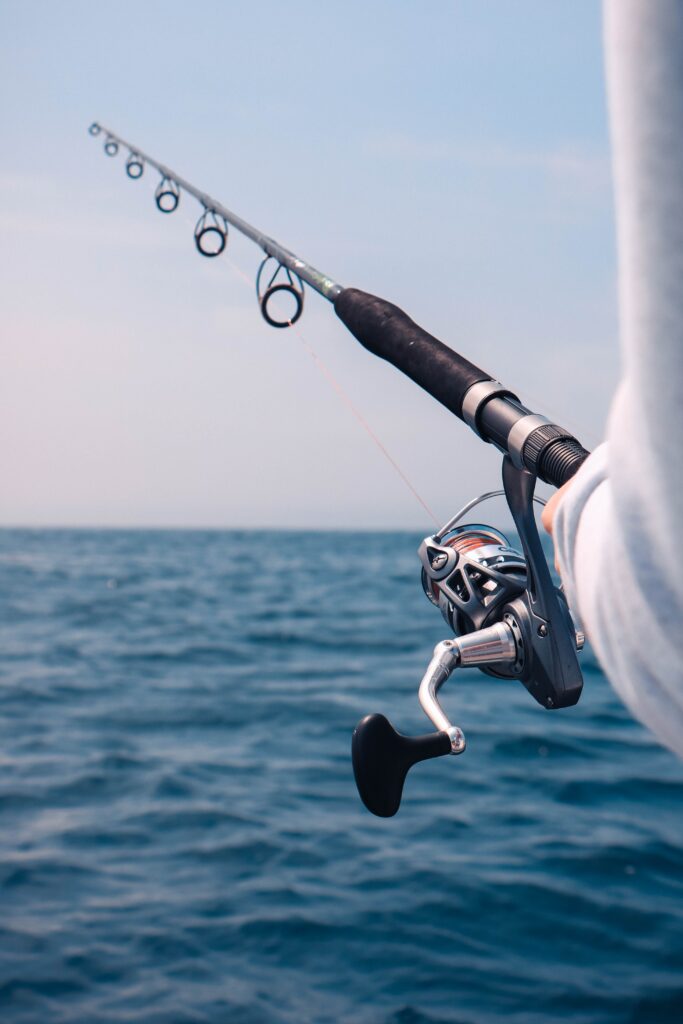
Understanding Summer Fish Behavior
Knowing the Impact of Warm Water on Fish Activity
Summer is characterized by warmer water temperatures, which can have a significant impact on fish behavior. In general, many fish species become more active and feed more aggressively in warmer waters. Warmer temperatures increase the metabolic rates of fish, making them more energetic and voracious. However, it’s important to note that extreme heat can also reduce oxygen levels in the water, leading fish to seek cooler depths or areas with more oxygenated water. By understanding the impact of warm water on fish activity, you can adjust your fishing strategies accordingly and target the most active fish.
Identifying Feeding Patterns
During the summer months, fish often exhibit specific feeding patterns that can be helpful to understand when planning your fishing trips. Many fish species, including bass and trout, are known to be more active during low-light periods such as early morning or late evening. These are prime times to target these species as they are more likely to be actively feeding. Pay attention to any surface activity or signs of baitfish in the water, as this can indicate a feeding frenzy. By identifying feeding patterns, you can increase your chances of success by fishing during the most productive times.
Understanding Spawning Behavior
Another critical factor to consider when fishing in the summer is the spawning behavior of fish. Many fish species, such as salmon or bass, spawn during the summer months. During this time, they may be less focused on feeding and more inclined to protect their nests or spawning sites. It’s important to respect these spawning areas and avoid disturbing fish during their spawning season. By understanding the spawning behavior of your target species and avoiding these areas, you can practice responsible fishing and contribute to the long-term sustainability of fish populations.
Selecting the Right Fishing Techniques
Using Topwater Lures
One popular fishing technique during the summer is using topwater lures. These lures mimic the action of prey fish swimming on the water’s surface, attracting predatory fish. Topwater lures can be effective for targeting species like bass, pike, or muskie. Use a variety of retrieves such as popping or walking the dog to create enticing movement and sound on the water’s surface. Experiment with different colors, sizes, and styles of topwater lures to find the most effective option for your target species and fishing conditions.
Utilizing Deep Diving Lures
When fish are holding in deeper water or seeking shelter from the summer heat, utilizing deep diving lures can be effective. These lures have a lip or bill that causes them to dive below the water’s surface when retrieved. They are designed to reach specific depths based on their design and the speed of retrieval. Deep diving lures can be effective for targeting species like walleye, striped bass, or trout. Vary the depth and speed of your retrieve to find the most productive combination for your target species and fishing location.
Trying Out Soft Plastic Baits
Soft plastic baits are versatile and effective fishing tools that can be used in various circumstances. During the summer, fish may be more finicky or less inclined to chase fast-moving lures, making soft plastic baits an excellent choice. These baits often mimic natural prey, such as worms, crayfish, or baitfish, and can be rigged in different ways to increase their appeal. Use techniques like Texas rigging, Carolina rigging, or drop shotting to present soft plastic baits effectively. Experiment with different colors and sizes to match the forage and preferences of your target species.
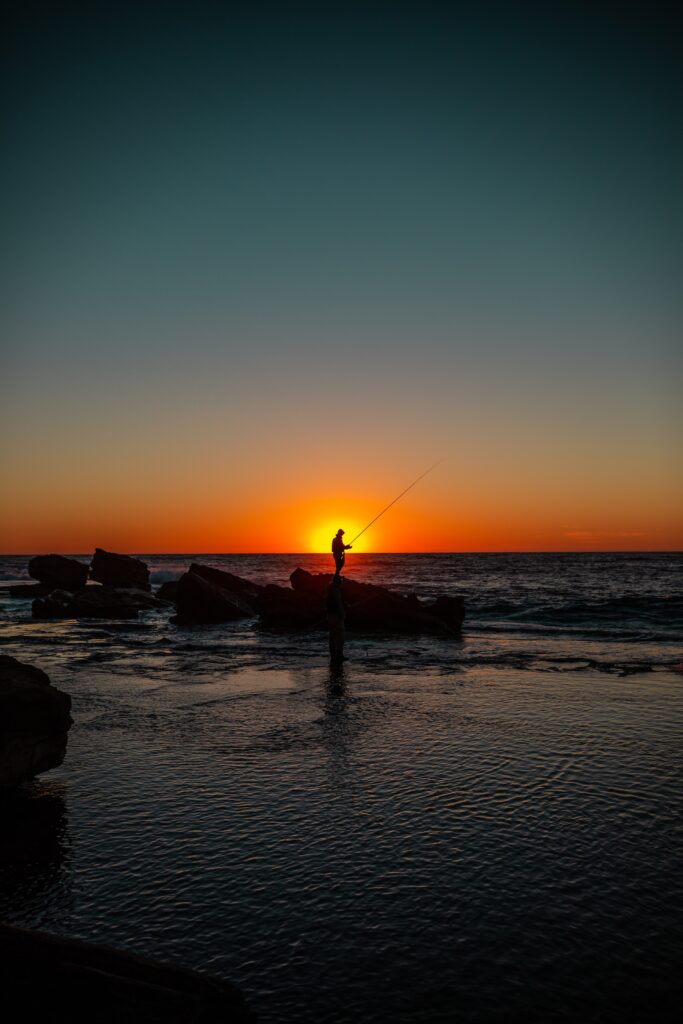
Mastering Different Fishing Methods
Casting and Retrieving Method
The casting and retrieving method is one of the most common and versatile fishing methods. It involves casting your line out into the water and retrieving it using various techniques, such as a steady retrieve, twitching, or jerking motions. This method allows you to cover a wide area and explore different depths and structures. It can be particularly effective for targeting species like bass, pike, or trout. Experiment with different retrieves and speeds to mimic the movement of natural prey and entice fish to bite.
Trolling Method
Trolling is a fishing method that involves dragging a line with bait or lures behind a moving boat. It allows you to cover a large area of water efficiently and can be effective for targeting species like salmon, walleye, or muskie. Consider using downriggers or planer boards to control the depth and distance of your bait. Vary your trolling speed and experiment with different lures or baits to find the most productive combination for your target species and fishing conditions.
Bottom Fishing Method
The bottom fishing method involves targeting fish that dwell near the bottom of the water column, such as catfish, flounder, or grouper. Use a sinker or weight to take your bait to the bottom and allow it to sit, enticing fish to bite. This method can be effective in deeper waters or areas with rocky or sandy bottoms. Experiment with different baits like shrimp, worms, or cut bait to determine what is most appealing to your target species.
Applying the Right Fishing Tactics
Using Slow and Steady Retrieval Speeds
During the summer months, fish may be more sluggish or have a slower metabolism due to warm water temperatures. In response, using slow and steady retrieval speeds can be an effective tactic. Slowing down your retrieve allows fish more time to spot and react to your bait or lure. It can also make your offering appear more natural and enticing. Pay attention to the behavior of your target species and adjust your retrieval speed accordingly. Sometimes, a slow and steady presentation can be the key to enticing a bite.
Experimenting with Color and Presentation
Fish can be selective, especially during the summer when natural food sources are abundant. To increase your chances of success, it’s essential to experiment with different colors and presentations. Try using lures or baits that closely resemble the natural forage in the water you are fishing. Pay attention to the clarity of the water and adjust your color choices accordingly. Additionally, consider the mood of the fish and modify your presentation, such as adding pauses, jerks, or twitches, to trigger a strike. By being adaptable and experimenting with different approaches, you can increase your chances of enticing fish to bite.
Adjusting Fishing Depth
Understanding the depth at which fish are feeding can significantly impact your fishing success. Experiment with adjusting your fishing depth to target fish at different levels of the water column. Use techniques like adding or removing weight to your line, changing the length of your leader, or adjusting your bobber placement. Pay attention to any signs of fish activity or baitfish, as this can indicate at what depth the fish are feeding. By adjusting your fishing depth, you can target fish more effectively and increase your chances of a successful catch.

Considering Environmental Factors
Monitoring Weather Conditions
Before heading out for a fishing trip, it’s crucial to monitor the weather conditions. Weather can have a significant impact on fish behavior and activity. Fish may become more or less active depending on factors such as temperature, wind, or barometric pressure. Pay attention to weather forecasts and plan your fishing trips accordingly. In general, stable weather conditions with mild temperatures and moderate wind can provide optimal fishing opportunities. Additionally, be prepared for sudden changes in weather and take appropriate measures to ensure your safety.
Understanding the Impact of Moon Phases
Moon phases can also play a role in fish behavior, especially for species like bass, walleye, or trout. During certain moon phases, fish may be more active or exhibit specific feeding patterns. For example, fish may feed more actively during a full moon or in the days leading up to it. Conversely, fish may be less active during a new moon or in the days following it. Paying attention to moon phases can help you plan your fishing trips and increase your chances of encountering active fish.
Taking into Account Water Clarity and Current
Water clarity and current are environmental factors that can significantly influence fish behavior and feeding patterns. Clear water allows fish to see prey more easily and can make them more cautious or selective. In this case, using natural-looking lures or baits and employing finesse techniques can be effective. Conversely, muddy or turbid water can reduce fish visibility, making them rely more on their sense of vibration or scent. In these conditions, lures or baits with contrasting colors or noise-producing elements can be more effective. When fishing in rivers or streams, pay attention to the direction and speed of the current, as fish tend to position themselves strategically to take advantage of the current flow.
Achieving Successful Catch and Release
Using Proper Handling Techniques
Catch and release fishing is an important practice for maintaining healthy fish populations and conserving fish resources. When practicing catch and release, it’s important to use proper handling techniques to minimize stress and injury to the fish. Handle the fish with wet hands or a wet cloth to avoid removing their protective slime layer. Use appropriate tools like a landing net or fish grips to handle the fish gently. If you need to remove the fish from the water, do so quickly and support its weight properly. Minimizing the time the fish spends out of the water and handling it with care will increase its chances of survival after release.
Using Barbless Hooks
Using barbless hooks when practicing catch and release fishing is highly recommended. Barbless hooks are easier to remove from a fish’s mouth, reducing the risk of injury to the fish. They also make the unhooking process quicker and more efficient, minimizing the time the fish spends out of the water. Barbless hooks are available for most types of fishing and are an important tool for practicing ethical and responsible angling.
Providing Adequate Revival Time
After catching a fish, it’s crucial to provide adequate revival time before releasing it back into the water. Hold the fish gently in the water, facing upstream, and allow it to recover its strength. The fish will let you know when it’s ready to swim away by giving a strong burst of energy. Be patient and ensure that the fish can swim away smoothly before letting go. Providing adequate revival time ensures that the fish has the best chance of survival after release.
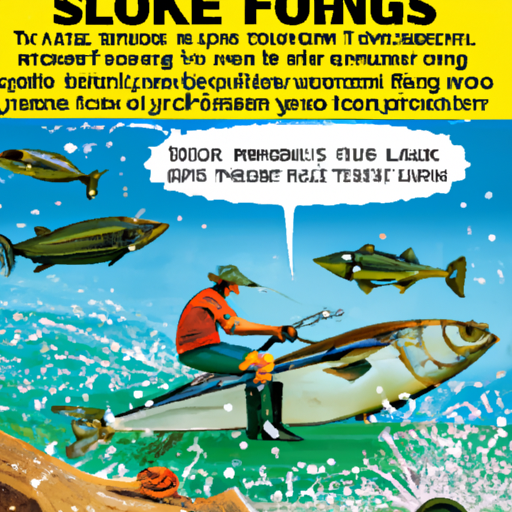
Ensuring Safety While Fishing
Using Proper Sun Protection
When spending time outdoors, especially during the summer months, it’s essential to use proper sun protection. Protect your skin and eyes from harmful UV rays by wearing sunscreen, sunglasses, and a wide-brimmed hat. Choose a sunscreen with a high SPF, and reapply it regularly, especially if you are fishing for an extended period. Sun protection is crucial for maintaining your health and enjoyment while fishing.
Maintaining Hydration and Nutrition
Spending time under the sun and engaging in physical activity while fishing can lead to dehydration and low energy levels. It’s important to stay hydrated by drinking plenty of water throughout your fishing trip. Pack an adequate supply of water and consider bringing electrolyte-enhanced drinks to replenish essential minerals lost through perspiration. Additionally, bring nutritious snacks or meals to maintain your energy levels. Proper hydration and nutrition will keep you alert and focused, ensuring a safe and enjoyable fishing experience.
Being Aware of Potential Hazards
Fishing often takes place in natural environments, which can present potential hazards. It’s important to be aware of your surroundings and take appropriate safety precautions. Look out for slippery or uneven surfaces, especially when fishing from rocks or piers. Be cautious of strong currents or changing tides in rivers or coastal areas. Additionally, be mindful of wildlife or insects that may be present in the area. Keep a safe distance and avoid disturbing or provoking them. By being aware of potential hazards and taking necessary precautions, you can fish safely and avoid accidents or injuries.
Staying Up-to-Date with Fishing Regulations
Checking Licensing Requirements
Before going fishing, it’s crucial to check the licensing requirements in your area. Fishing regulations vary by location and may require you to have a valid fishing license or permit. Familiarize yourself with the specific regulations and ensure that you comply with them. Fishing without the necessary permits or licenses can result in fines or penalties. By staying up-to-date with the licensing requirements, you can fish legally and responsibly.
Confirming Seasonal Restrictions
Seasonal restrictions, such as closed seasons or specific catch limits, are put in place to protect fish populations during vulnerable times. These restrictions may limit the type, size, or quantity of fish you can catch and keep. It’s essential to confirm any seasonal restrictions in your area and adhere to them. Check with local authorities or consult fishing guides for any updated information on seasonal restrictions. By following these restrictions, you contribute to the conservation of fish populations and ensure their sustainability for future generations.
Understanding Catch Limits
Catch limits are regulations that specify the number of fish an angler can catch and keep within a specific timeframe. These limits are designed to prevent overfishing and ensure the long-term sustainability of fish populations. It’s important to understand the catch limits for your target species and strictly adhere to them. Keep track of the fish you catch and release any fish beyond the allowed limit. By respecting catch limits, you play an active role in conserving fish populations and maintaining the balance of ecosystems.
In conclusion, choosing the right fishing spot, creating a fishing plan, understanding summer fish behavior, selecting the right fishing techniques, mastering different fishing methods, applying the right fishing tactics, considering environmental factors, achieving successful catch and release, ensuring safety while fishing, and staying up-to-date with fishing regulations are essential aspects of successful and responsible angling. By incorporating these strategies and practices into your fishing trips, you can increase your chances of a rewarding and enjoyable fishing experience while contributing to the long-term sustainability of fish populations and their habitats. Happy fishing!



